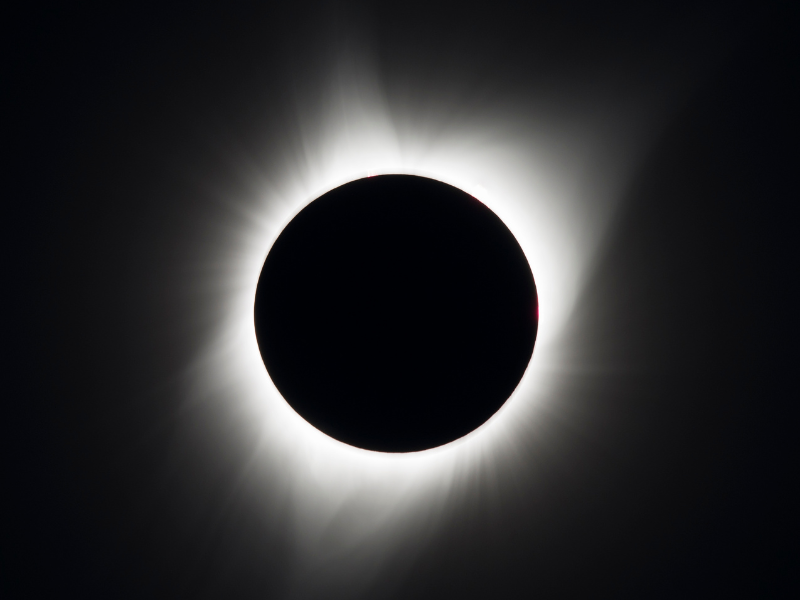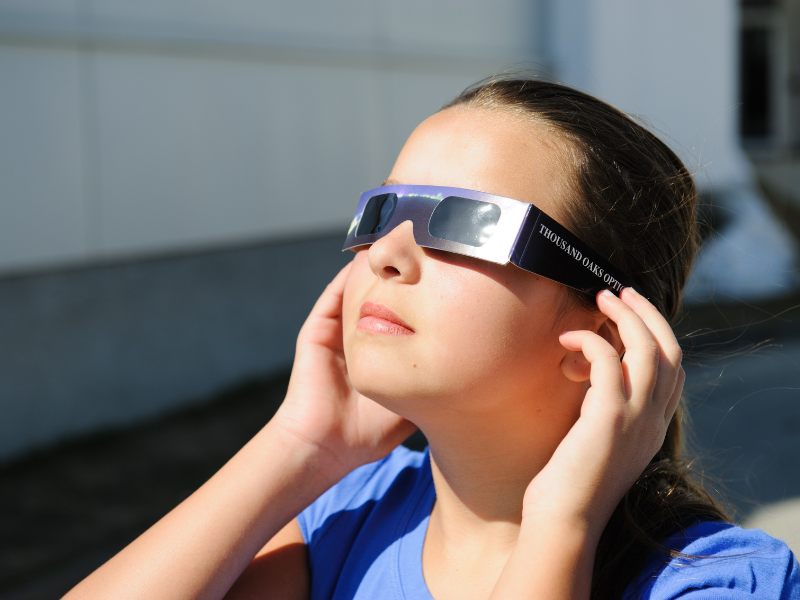Total Solar Eclipse: Answers to Common Questions
On April 8, 2024, residents in the southern part of Québec will have the opportunity to watch a total solar eclipse. This is a rare astronomical event... and a once-in-a-lifetime event! The last total solar eclipse that was visible from Québec goes back to 1972. Many of you have questions as the big day approaches: What’s the best way to watch? How safe is it? The Montréal Science Centre team has answers to some of the most common questions. Here they are!
What kind of gear will help me make the most of the eclipse?
Special glasses are made just for watching solar eclipses. To be safe, these glasses have to meet international standards, ISO 12312-2:2015 to be exact. The ones we will be handing out for free in front of the Science Centre on April 8 during our free event meet those standards.

You can also use binoculars or a telescope equipped with the same standard filter you find on eclipse glasses. Binoculars with the special filter offer the best way to watch a solar eclipse according to eclipse chasers!
You can also watch a solar eclipse using an indirect viewing method. Any object with small holes will do, like a strainer, a slotted spoon, or even a cheese grater. Talk about an opportunity to get creative! Here’s a useful guide to help you build your own eclipse projector.
What kind of gear should NEVER be used to watch the eclipse?
Here is a list of gear you should NOT use to watch the eclipse. They do NOT keep your eyes safe:
- Sunglasses (forget about wearing multiple pairs too, sunglasses will not protect your eyes)
- Tinted or smoked glass
- Photographic film that has been exposed (the kind that looks black)
- Polarizing filters (used in photography)
- Potato chip bags
- Mylar blankets (also known as foil or space blankets)
- X-ray film
- An old CD or DVD
Will it be dangerous to look at the April 8 eclipse without eye protection?
Depends on when you look. During a total solar eclipse, the Moon moves in front of the Sun and covers it completely for a short while. This short period of time is called the moment of totality. It only lasts a few minutes, and this is the moment when you can look at the eclipse with your naked eye, but only during this short moment. In fact, if you’re wearing your eclipse glasses during the moment of totality, you won’t see anything at all. So you don’t need special gear to view the big moment of the eclipse. In Montréal, the moment of totality will happen during the minute between 3:27pm and 3:28pm.
The time leading up to (and after) the moment of totality is known as the partial phase of the eclipse. The brightness of the Sun is softened and easier to look at, which reduces our natural reflex to look away. But remember, even if the Sun is partially covered by the Moon, the rays of the Sun are still sending light to your eye and can burn the light-sensitive cells on your retinas. That’s why it’s so important to wear protective eye gear during the partial phases of the eclipse. The partial phases last for several hours. In Montréal, this will be from about 2:14pm to 3:27pm and again from 3:28pm to 4:36pm.

Here’s how to go about watching. Remove your eclipse glasses when the last tiny sliver of the Sun disappears. With your naked eye, you’ll see a black circle (that’s the Moon) surrounded by the white light of the solar corona. When you see the corona disappear, that’s your cue to put your eclipse glasses back on right away, because that marks the end of the moment of totality and the rays from the Sun will start landing on your eye again.
Is eclipse viewing dangerous for children?
As we talked about earlier, it is completely safe to watch the eclipse with your naked eye, even children, during the moment of totality.
During the partial phases, children are no more at risk to be injured by the Sun’s rays… but they are more likely to forget the rules! We recommend that parents and guardians explain all the safety rules to the children under their care and keep a close eye on children under the age of six during the eclipse.
Still, don’t worry! During the total solar eclipse in the US in 2017, fewer than 100 people reported experiencing damage to their eyes while watching the eclipse… out of 215 million people who watched! Risk of permanent damage is quite slim so long as you take the necessary precautions.

Will I see the total eclipse from my city?
Maybe, maybe not! Not all cities in Québec will see the total solar eclipse on April 8. The total eclipse will be visible in southern parts of Québec only, so Montréal, Montréal’s south shore, the Montérégie region, and the Eastern Townships.
Other regions will only be able to see a partial eclipse. To find out if you will be able to see the total eclipse from your city, look for it on the interactive map below, or download the Mon éclipse app. Use these tools to choose the best viewing location!
What should I do with my eclipse glasses after the big day?
We recommend keeping your eclipse glasses in a safe place to avoid tossing them in the trash. They can absolutely be reused! You can reuse them in the future to watch a total or a partial eclipse. You can also use them on sunny days to look at sunspots!
Some glasses and visors have a warning on them that says that you can’t use them for more than three minutes at a time and that they have to be thrown out after three years. This may be true for older models but this is not the case for eclipse glasses that are ISO 12312-2:2015 certified.
Any pair of eclipse glasses that have this certification can be reused for a long, long time… even forever! Well, so long as they are not broken, that is. So, don’t forget to inspect them for signs of damage before putting them on!
Join us on April 8, starting at 1pm, for our eclipse viewing event in front of the Science Centre. An event presented by Cirque du Soleil!
Sources
-
Agency, C. S. (2017). Solar eclipses guide: When is the next solar eclipse? Canadian Space Agency. https://www.asc-csa.gc.ca/eng/astronomy/eclipses/solar-eclipses.asp
-
Carte interactive pour le simulateur des éclipses de 2024 | Eclipse2024.org. (n.d.) https://eclipse2024.org/eclipse_cities/statemap.html
-
Fréquence des éclipses de Soleil. (s.d.) Espace pour la vie. https://espacepourlavie.ca/frequence-des-eclipses-de-soleil
-
How Do You Tell the Difference Between Total, Annular, Solar, and Lunar Eclipses? | Britannica. (n.d.) https://www.britannica.com/story/how-do-you-tell-the-difference-between-total-annular-solar-and-lunar-eclipses
-
National Geographic (Réalisateur). (2017). Solar Eclipse 101 | National Geographic. https://www.youtube.com/watch?v=cxrLRbkOwKs
-
Next year will be the last chance to see a total solar eclipse from the U.S. for more than 20 years. (2023) https://www.cbsnews.com/news/total-solar-eclipse-2024-last-chance-see-us-20-years-nasa/
-
Overview | 2024 Total Eclipse. (n.d.) NASA Solar System Exploration. https://solarsystem.nasa.gov/eclipses/2024/apr-8-total/overview
-
S.L, T. N. (n.d.) Éclipse solaire à Montréal le 8 avril 2024 (Canada) | éclipse totale. www.tutiempo.net. https://fr.tutiempo.net/eclipse-solaire/montreal/8-avril-2024.html
-
Solar eclipse. (n.d.) https://www.cs.mcgill.ca/~rwest/wikispeedia/wpcd/wp/s/Solar_eclipse.htm
-
Andrews, T. M. (2021 October 25). The solar eclipse burned a crescent wound on a woman’s retina. She wasn’t wearing proper glasses. Washington Post. https://www.washingtonpost.com/news/morning-mix/wp/2017/12/08/the-solar-eclipse-burned-a-crescent-wound-on-a-womans-retina-she-wasnt-wearing-proper-glasses/
-
Comment bien observer les éclipses—En toute sécurité. (2023 January 31). https://www.eclipsequebec.ca/observer-de-maniere-securitaire/
-
ICI.Radio-Canada.ca, Z. É.-. (n.d.). Les lunettes pour éclipse solaire, une occasion d’affaires pour des entreprises. Radio-Canada; Radio-Canada.ca https://ici.radio-canada.ca/nouvelle/2053503/lunettes-eclipes-solaire-regarder
-
● ICI.Radio-Canada.ca, Z. S.-. (n.d.-a). Où et quand regarder l’éclipse solaire du 8 avril? Comment le faire en sécurité? Radio-Canada; Radio-Canada.ca. https://ici.radio-canada.ca/nouvelle/2046009/eclipse-soleil-8-avril-ontario-quebec-conseils
-
ICI.Radio-Canada.ca, Z. S.-. (n.d.-b). Où serez-vous pour observer l’éclipse totale du Soleil le 8 avril? Radio-Canada; Radio-Canada.ca. https://ici.radio-canada.ca/nouvelle/2052917/eclipse-totale-soleil-avril-canada-quebec-montreal
-
Profiter de l’éclipse solaire en toute sécurité ! - CIUSSS de l’Estrie—CHUS. (s. d.). https://www.santeestrie.qc.ca/nouvelle/profiter-de-leclipse-solaire-en-toute-securite
-
Rick, Fienberg. (2016 December 1). How to View a Solar Eclipse Safely [Text]. Solar Eclipse Across America. https://eclipse.aas.org/eye-safety
-
Safety—NASA Science. (n.d.). https://science.nasa.gov/eclipses/safety/
-
Solar Eclipse Safety | The Canadian Association of Optometrists. (n.d.). https://opto.ca/eye-health-library/solar-eclipse-safety
-
Solar eclipse guide: What they are and how to watch safely. (n.d.). https://www.nhm.ac.uk/discover/solar-eclipse-guide.html
-
